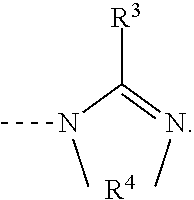Amidine catalyst for curable compositions
a technology of amidine and catalyst, which is applied in the field of amidines, can solve the problems of significant health hazards, toxicological concerns, and potential hazard to users and the environment, and achieve the effects of high selectivity, rapid curing of the composition, and high catalytic activity
- Summary
- Abstract
- Description
- Claims
- Application Information
AI Technical Summary
Benefits of technology
Problems solved by technology
Method used
Image
Examples
Embodiment Construction
[0295]Adduced hereinafter are working examples which are intended to elucidate the invention described in detail. It will be appreciated that the invention is not restricted to these described working examples.
[0296]“Standard climatic conditions” refer to a temperature of 23±1° C. and a relative air humidity of 50±5%.
[0297]“EEW” stands for epoxy equivalent weight.
[0298]1H NMR spectra were measured on a spectrometer of the Bruker Ascend 400 type at 400.14 MHz; the chemical shifts δ are reported in ppm relative to tetramethylsilane (TMS). Coupling constants J are reported in Hz. No distinction was made between true coupling and pseudo-coupling patterns. Infrared spectra (FT-IR) were measured on a Nicolet iS5 FT-IR instrument from Thermo Scientific equipped with a horizontal ATR measurement unit with a diamond crystal. Liquid samples were applied undiluted as films; solid samples were dissolved in CH2Cl2. The absorption bands are reported in wavenumbers (cm−1) (measurement window: 4000...
PUM
| Property | Measurement | Unit |
|---|---|---|
| temperature | aaaaa | aaaaa |
| temperature | aaaaa | aaaaa |
| temperature | aaaaa | aaaaa |
Abstract
Description
Claims
Application Information
 Login to View More
Login to View More - R&D
- Intellectual Property
- Life Sciences
- Materials
- Tech Scout
- Unparalleled Data Quality
- Higher Quality Content
- 60% Fewer Hallucinations
Browse by: Latest US Patents, China's latest patents, Technical Efficacy Thesaurus, Application Domain, Technology Topic, Popular Technical Reports.
© 2025 PatSnap. All rights reserved.Legal|Privacy policy|Modern Slavery Act Transparency Statement|Sitemap|About US| Contact US: help@patsnap.com



